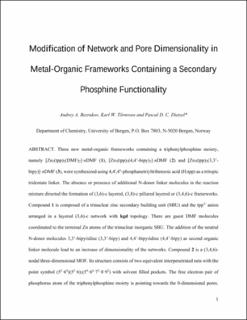| dc.description.abstract | Three new metal-organic frameworks containing a triphenylphosphine moiety, namely [Zn3(tpp)2(DMF)2]·nDMF (1), [Zn3(tpp)2(4,4’-bipy)2]·nDMF (2) and [Zn3(tpp)2(3,3’-bipy)]·nDMF (3), were synthesized using 4,4',4''-phosphanetriyltribenzoic acid (H3tpp) as a tritopic tridentate linker. The absence or presence of additional N-donor linker molecules in the reaction mixture directed the formation of (3,6)-c layered, (3,8)-c pillared layered or (3,4,6)-c frameworks. Compound 1 is composed of a trinuclear zinc secondary building unit (SBU) and the tpp3- anion arranged in a layered (3,6)-c network with kgd topology. There are guest DMF molecules coordinated to the terminal Zn atoms of the trinuclear inorganic SBU. The addition of the neutral N-donor molecules 3,3’-bipyridine (3,3’-bipy) and 4,4’-bipyridine (4,4’-bipy) as second organic linker molecule lead to an increase of dimensionality of the networks. Compound 2 is a (3,4,6)-nodal three-dimensional MOF. Its structure consists of two equivalent interpenetrated nets with the point symbol (52·64)(52·6)2(54·66·72·8·92) with solvent filled pockets. The free electron pair of phosphorus atom of the triphenylphosphine moiety is pointing towards the 0-dimensional pores. The structure of 3 can be described as layers of 1 which are connected by additional 3,3’-bipyridine as pillar into a three-dimensional (3,8)-c network with the point symbol (43)2(46·618·84). The non-interpenetrated structure of 3 contains a solvent filled three-dimensional pore system. All three materials exhibit uptake of CO2 at 195 K after removal of the guest DMF molecules. It is particularly surprising for 2, with its 0-dimensional pores in the single crystal structure and absence of N2 adsorption at 77 K. 3 showed a large gate opening effect for CO2 adsorption at 195 K. | en_US |
